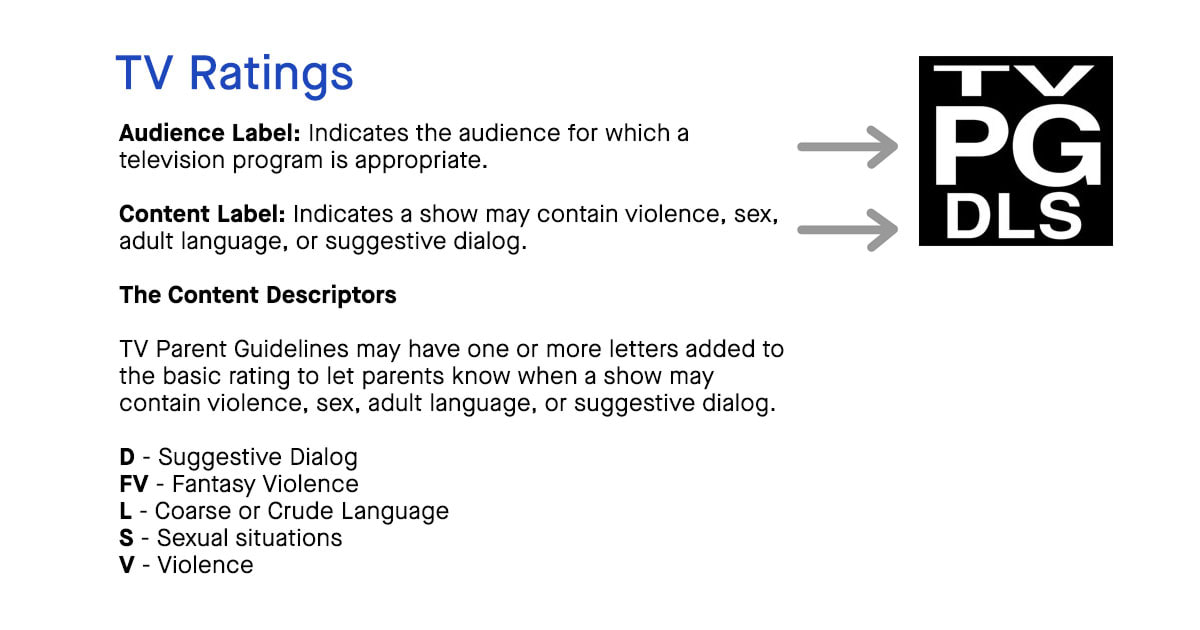TV ratings system guide
The way we watch our favorite TV shows and movies has changed significantly with the evolution of streaming services such as Netflix, Hulu, Amazon Prime and other platforms. With video content so easily available, it may be difficult for parents to know what their children are watching. Many parents are concerned about their child watching shows or movies with inappropriate content. Fortunately, there are ways parents can monitor what their children are watching by using TV ratings systems, which indicate the content and age-appropriateness of TV shows. Explore this guide to learn about the different types of TV ratings.
Understanding the TV ratings
The television industry designed the TV Parental Guidelines as a ratings system that gives parents information about the appropriate age ranges for different content. These guidelines were modeled after the film ratings to make them easy to recognize. Below is a visual for what a ratings icon looks like, with information about the different content descriptors.

Most television programs, except for sports and news shows, have the ratings icon and content descriptors at the beginning of the show or program, usually in the upper-left corner of the screen. For shows that last more than one hour, the ratings icon will appear at the beginning of the second hour. As some ratings can change episode-by-episode, it’s important to check at the start of the show what the rating is before letting your child begin viewing.
Types of TV ratings
Below is a more in-depth look at the different types of TV ratings you may see appear at the start of the program. Read the information below to get a better understanding of what TV programs are suitable for certain age groups and why.
- TV-Y: All Children – Programming that has this type of rating is most suitable for children ages 2 to 6. Whether it is an animated or live action show, the themes of the program are designed for a very young audience and are unlikely to scare young children.
- TV-Y7: Directed to Older Children – For programs with the TV-Y7 rating, you will find mild fantasy or comedic violence that’s usually suitable for children ages 7 and above. Some themes or components of the show may frighten children younger than age 7. Therefore, parents may want to consider not letting younger children watch this type of program.
- TV-Y7 FV: Directed to Older Children, Fantasy Violence – One of the main differences between TV-Y7 and TV-Y7 FV programs is that TV-Y7 programs contain fantasy violence that may not be suitable for younger children (under age 7) to watch. This type of programing is created with the intent that older children will be watching.
- TV-G: General Audience – Most parents who found programs rated TV-G would agree it is suitable for all ages, as it contains little or no violence, no strong language and little or no sexual dialogue or situations. Parents may feel comfortable letting younger children watch this type of programming with little or no supervision.
- TV-PG: Parental Guidance Suggested – These programs contain material that some parents may find unsuitable for children to view. This rating calls for parental guidance and may include additional ratings such as these: dialogue (D), infrequent coarse or crude language (L), some sexual situations (S), and some moderate violence (V). Watch out for these additional ratings as they may help guide you in making the decision on whether the program is suitable for your child to view.
- TV-14: Parents Strongly Cautioned – The “14” in this TV-14 rating is an indicator here of the age group that’s deemed appropriate for a TV-14 program: children above the age of 14. Therefore, some parents may not deem suitable for children under the age of 14. At the start of the program, you may notice additional ratings pop up, including suggestive dialogue (D), coarse or crude language (L), intense sexual situations (S), or intense violence (V). Parents are urged to exercise more care and attention if letting their children watch these programs.
- TV-MA: Mature Audience Only – This TV rating warrants extreme caution if children under the age of 17 are watching, as this type of programming is designed to be viewed by adults. It is usually not suitable for children under the age of 17, as it includes explicit sexual activity (S), extremely graphic violence (V), and indecent language (L).
Sometimes the same television series may be edited differently based on when they air and which channel or streaming service is presenting them. For example, premium cable like HBO or Showtime may show content that hasn’t been edited for younger audiences compared to that of basic cable or broadcast channels. Before you let your child watch a new show on a streaming service platform or through cable TV, understanding this TV ratings guide may help you decide which types of content are best for your young ones or teens.
Discover other useful guides and tips in the CenturyLink Support Center, including resources on different streaming devices, how to watch sports with streaming TV and more.
Did you find the help you were looking for today?
Support topics





.png)





